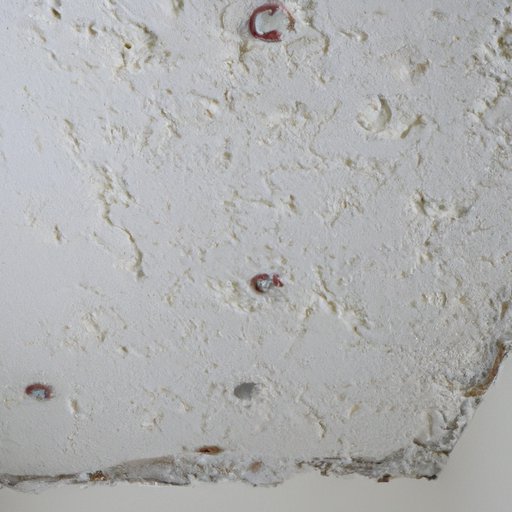Introduction
Popcorn ceilings, also known as cottage cheese or textured ceilings, have been a popular home design choice for decades. The textured look was used to mask imperfections in ceilings and give them a more modern appearance. However, in recent years, many homeowners have begun to question whether popcorn ceilings are really that bad.

Examining the Pros and Cons of Popcorn Ceilings
When it comes to deciding whether or not a popcorn ceiling is good or bad, there are both pros and cons to consider. Here’s a closer look at each:
Pros
One of the biggest advantages of popcorn ceilings is their affordability. While other types of ceiling treatments can be quite expensive, popcorn ceilings are relatively inexpensive and easy to install. They also do a great job of hiding imperfections in ceilings, making them a great choice for homes with older ceilings or those with minor damage.
Cons
On the other hand, popcorn ceilings come with some major drawbacks. For starters, they often collect dust and dirt, making them difficult to keep clean. Additionally, they can obscure lighting fixtures and vents, making it difficult to access these areas for repairs or upgrades. Finally, many people find popcorn ceilings unattractive and outdated, which can decrease the value of your home.
Are Popcorn Ceilings Really That Bad?
The answer to this question depends on your individual situation. If you have an older home with popcorn ceilings already installed, then it may be worth keeping them. However, if you’re considering installing a popcorn ceiling in a new home, then there are some important things to consider.
How to Tell if Your Popcorn Ceiling Contains Asbestos
If your home was built before 1980, then it’s possible that your popcorn ceiling contains asbestos. Asbestos is a mineral fiber that was commonly used in building materials prior to the 1980s. It can be dangerous if inhaled, so it’s important to determine whether or not your popcorn ceiling contains asbestos before attempting to remove it yourself.
Is it Safe to Remove a Popcorn Ceiling?
In most cases, it is safe to remove a popcorn ceiling yourself. However, if your popcorn ceiling contains asbestos, then you should hire a professional to handle the removal process. In either case, it’s important to take the necessary safety precautions to protect yourself and your family from any potential health risks.

DIY Guide to Removing Popcorn Ceilings
If you decide to tackle the task of removing your popcorn ceiling yourself, then here’s a step-by-step guide to help you get started:
Step-by-Step Instructions for Removal
1. Start by covering the floor and furniture with plastic sheeting to protect them from water and debris.
2. Using a garden sprayer, spray the ceiling with a mixture of warm water and dish soap.
3. Allow the mixture to sit for 15-20 minutes.
4. Use a putty knife or drywall scraper to scrape off the popcorn texture.
5. Vacuum up any remaining debris.
6. Patch any holes or cracks in the ceiling with joint compound.
7. Sand the patched area until it’s smooth.
8. Prime and paint the ceiling with a high-quality paint.
Safety Precautions to Take
It’s important to take the necessary safety precautions when removing a popcorn ceiling. Make sure to wear protective gear, such as a respirator, goggles, and gloves, to protect yourself from any potential hazards. Additionally, it’s a good idea to open windows in the room to allow for proper ventilation.
The Environmental Impact of Popcorn Ceilings
In addition to the potential health risks associated with popcorn ceilings, there are also environmental concerns to consider. Here’s a closer look at the materials used in popcorn ceilings and how to properly dispose of them:
What Materials Are Used in Popcorn Ceilings?
Popcorn ceilings are typically made with a combination of gypsum board and a special texturing compound. The texturing compound is usually made with styrene-butadiene rubber, acrylic, and other chemicals. These materials can be hazardous to the environment if not disposed of properly.
Disposal Guidelines
If you’ve removed a popcorn ceiling and need to dispose of it, it’s important to do so responsibly. Contact your local waste management company to find out what disposal guidelines they recommend. In most cases, the debris should be placed in a sealed bag and taken to a hazardous waste facility for proper disposal.

5 Creative Alternatives to Popcorn Ceilings
If you’re looking for a way to update your home without the hassle of removing a popcorn ceiling, then there are plenty of creative alternatives to choose from. Here’s a look at five of the most popular options:
Different Textures and Finishes
From stucco to Venetian plaster, there are a variety of different textures and finishes you can choose from to give your ceiling a unique look. You can even combine different textures and finishes to create a one-of-a-kind design.
Cost Comparison
While some alternative ceiling treatments can be quite costly, there are also some budget-friendly options available. Be sure to compare prices before deciding which option is best for you.
Conclusion
Popcorn ceilings have been a popular home design choice for decades. However, in recent years, many homeowners have begun to question whether popcorn ceilings are really that bad. While there are both pros and cons to consider, the decision ultimately comes down to personal preference. If you decide to remove your popcorn ceiling, make sure to do so safely and responsibly. Additionally, there are plenty of creative alternatives to choose from if you’re looking for a way to update your home without the hassle of removal.


